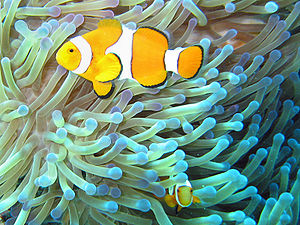Symbiosis
![]()
This article is about symbiosis in biology, for other meanings see Symbiosis (disambiguation).
Symbiosis (from ancient Greek σύν sýn, German 'together', and ancient Greek βίος bíos, German 'life') refers to the association of individuals of two different species that is beneficial to both partners.
Based on his work on lichens, Anton de Bary proposed in 1878 at the 51st Assembly of German Naturalists and Physicians in Kassel to introduce the term symbiosis into biology for any coexistence of organisms of different species, i.e. also for parasitism. In this broad sense, the term symbiosis is still used in US literature for all forms of co-evolutionary coexistence, from mutualism to commensalism, neutralism and parasitism. In Europe, on the other hand, the term symbiosis is used in the narrower sense defined at the beginning.
In symbioses between living organisms that differ considerably in size, the larger partner is often referred to as the host, and the smaller partner as the symbiont.

False Clownfish (Amphiprion ocellaris) and Magnificent Anemone (Heteractis magnifica)
Frequency of symbioses
Most of the biomass on earth consists of symbiotic systems, as a large proportion of trees and shrubs depend on pollination by other species. In addition, there are lichens, a symbiotic community between a fungus and green algae or cyanobacteria. Many sessile marine invertebrates living in shallow water, such as fire corals, most floral animals, and giant clams, cohabit with photosynthesizing zooxanthellae. Another example is the gastric and intestinal bacteria of animals, which enable the digestion of cellulose-rich plant food in ruminants, for example.
Distinction according to the degree of interdependence
One way of distinguishing between different forms of symbiosis is by the degree of interdependence of the species involved:
- Protocooperation (alliance): Loosest form of symbiosis: Both species derive an advantage from living together, but are equally viable without each other.
- Mutualism: regular but not vital relationship of symbionts.
- Eusymbiosis, also obligate symbiosis (ancient Greek εὖ eu "good, genuine"): In eusymbiosis, the partners are no longer viable on their own. Leafcutter ants, for example, cultivate fungi in their burrow on which they feed; the fungi, in turn, cannot reproduce without the ants.
Questions and Answers
Q: What is symbiosis?
A: Symbiosis is a close and long-term relationship between different species that live together.
Q: Who coined the term "symbiosis"?
A: The term was used by Anton de Bary in 1879.
Q: What is an endosymbiont?
A: An endosymbiont is an organism living inside another species, or a microscopic symbiont living inside the cells of a host.
Q: How important are symbiotic relationships to larger organisms?
A: Symbiotic relationships are of great importance to larger organisms, who in most cases would be unable to live as they do without their symbionts.
Q: Are humans an exception when it comes to having symbiotic relationships?
A: No, humans are not an exception when it comes to having symbiotic relationships.
Q: What are some examples of these associations between organisms from different kingdoms?
A: Mycorrhiza in higher plants and gut flora in insects and vertebrates are examples of associations between organisms from different kingdoms.
Q: How significant has symbiosis been for the evolution of life?
A: Symbiosis has been highly significant for the evolution of life, as most higher plants or animals have symbionts and cells of all eukaryotes contain organelles which are descendants of ancient symbiotic relationships.
Search within the encyclopedia